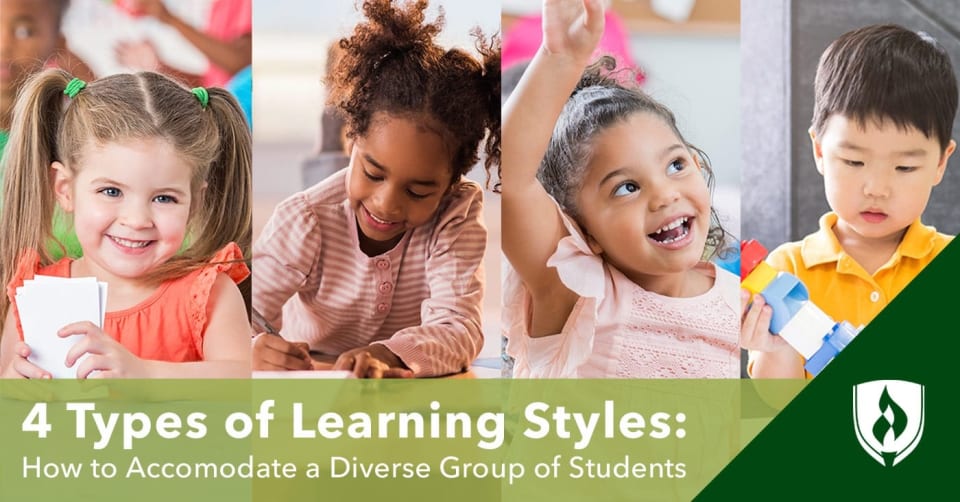What Are The Different Styles Of Learning

We all feel the world in unique means, and with that comes variation in the ways we acquire best. Agreement these dissimilar types of learning styles can drastically touch the manner teachers handle their students, ready up group projects and adapt private learning. Without understanding and acknowledging these unlike ways of learning, teachers might end up with a scattering of students lagging behind their classmates—in part because their unique learning style hasn't been activated.
Part of your responsibility as an educator is to adjust your lessons to the unique group of students yous are working with at whatsoever given time. The best teachers can cater to each student'due south strengths, ensuring they are truly grasping the data.
And then how do you run into the needs of dissimilar types of learners in your grade? Join u.s. as we outline the iv types of learning styles and how teachers can practically apply this information in their classrooms.
Ways of learning: A closer look at 4 learning styles
Learning styles and preferences take on a diversity of forms—and not all people fit neatly into i category. But generally speaking, these are the nearly mutual types of learners:
ane. Visual learners
How to recognize visual learners in your class: Someone with a preference for visual learning is partial to seeing and observing things, including pictures, diagrams, written directions and more. This is also referred to equally the "spatial" learning style. Students who learn through sight understand data improve when information technology'south presented in a visual way. These are your doodling students, your list makers and your students who take notes.
How to cater to visual learners: The whiteboard or smartboard is your best friend when teaching these types of learners. Give students opportunities to describe pictures and diagrams on the lath, or ask students to doodle examples based on the topic they're learning. Teachers catering to visual learners should regularly brand handouts and use presentations. Visual learners may as well need more time to process material, as they discover the visual cues before them. So be certain to requite students a little fourth dimension and space to absorb the information.
2. Auditory learners
How to recognize auditory learners in your form: Auditory learners tend to learn improve when the discipline affair is reinforced by audio. These students would much rather listen to a lecture than read written notes, and they frequently use their own voices to reinforce new concepts and ideas. These types of learners prefer reading out loud to themselves. They aren't agape to speak upwards in class and are great at verbally explaining things. Additionally, they may exist slower at reading and may oft repeat things a teacher tells them.
How to cater to auditory learners: Since these students generally notice it hard to stay quiet for long periods of time, get your auditory learners involved in the lecture by request them to repeat new concepts dorsum to yous. Enquire questions and let them answer. Invoke group discussions and so your auditory and exact processors can properly accept in and understand the information they're being presented with. Watching videos and using music or audiotapes are likewise helpful ways of learning for this group.
3. Kinesthetic learners
How to recognize kinesthetic learners in your class: Kinesthetic learners, sometimes called tactile learners, learn through experiencing or doing things. They similar to get involved past interim out events or using their hands to touch and handle in order to understand concepts. These types of learners might struggle to sit still and often excel at sports or similar to dance. They may need to accept more than frequent breaks when studying.
How to cater to kinesthetic learners: The all-time way teachers can help these students larn is by getting them moving. Instruct students to deed out a certain scene from a book or a lesson yous're didactics. Likewise endeavour encouraging these students by incorporating movement into lessons: pacing to help memorize, learning games that involve moving effectually the classroom or having students write on the whiteboard as function of an action.
Once kinesthetic learners can physically sense what they're studying, abstruse ideas and difficult concepts go easier to empathise.
4. Reading/writing learners
How to recognize reading/writing learners in your form:According to the VARK Modalities theory adult by Fleming and Mills in 1992, reading/writing learners prefer to learn through written words. While there is some overlap with visual learning, these types of learners are fatigued to expression through writing, reading articles or books, writing in diaries, looking upward words in the dictionary and searching the internet for just about everything.
How to cater to reading/writing learners:Of the 4 learning styles, this is probably the easiest to cater to since much of the traditional educational system tends to middle on writing essays, doing inquiry and reading books. Be mindful about allowing plenty of fourth dimension for these students to blot information through the written word, and give them opportunities to get their ideas out on newspaper as well.
Cover all types of learning
Understanding these different learning styles doesn't end in the classroom. By equipping students with tools in their early on years, teachers are empowering them for their futures. Pinpointing how a child learns best can dramatically impact their ability to connect with the topics you lot're teaching, as well as how they participate with the rest of the class.
Now that you have some tactics in your back pocket to accommodate different ways of learning, you may be curious about classroom management strategies. Learn more than in our commodity, "Proven Classroom Management Tips for Preschool Teachers ."
EDITOR'Southward NOTE: This article was originally published in 2018. It has since been updated to include information relevant to 2020.
Source: https://www.rasmussen.edu/degrees/education/blog/types-of-learning-styles/
Posted by: princethatic.blogspot.com


0 Response to "What Are The Different Styles Of Learning"
Post a Comment